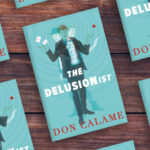All fiction can transport the reader to another time and place. Historical fiction requires a balance of creativity and factual research on real people and events to tell a unique story. Historical fiction helps to develop awareness of a major event and the impact it has on our modern lives. It can also give readers insight into a member of past society and produce empathy and connection to the lives of others.
Let me tell you the truth: History is a compound word. There are two words embedded within the word. Let me explain. History is really saying to us, “Hi, Story!” Stories are fun to listen to, interesting to read, and to write. Our world revolves around a story. Stories define and shape the world we live in. And eventually, every story becomes a “history.” When I was young, I didn’t particularly like reading history. In those days, learning history amounted to memorizing dates and facts. If I was good at remembering, I passed the test. Too often the humanity of the event was not at the center of the story. It wasn’t until I was an adult that I discovered the personal human story inside the impersonal historical event.
When I think about the way history is taught, it is often shared in big broad strokes—the big picture. The Civil War began in 1861, and reading about it now might seem impersonal and too far away to connect. “I wasn’t there when it happened, so it’s hard to relate.”
But someone was there.
For example, while in school reading about the Great Flood of 1927, it was just a story about when the Mississippi River flooded. But I got a totally different feeling and understanding when I heard my grandfather talk about it firsthand. He was actually there! Now I could believe it was a real thing. It impacted people; people I knew and cared about. I thought somewhere between the words and those pictures inside my history book was my grandfather’s story. Certainly, it is impossible to have this experience with every historical event that occurred, but that is where imagination and history unite. I experimented with this as a young teacher.
Combining history with creative writing uses both sides of the brain—the analytical part and the creative part. Having students write historical fiction is a wonderful way to check for understanding facts while allowing students to use their critical thinking to imagine the actual event and put some part of their humanity at the center of the story.
Years ago, as a special education middle school teacher teaching a unit on Mexico, I had my students take notes and write on certain aspects of the country. They researched Mexico’s geography and culture, such as how birthday parties or holidays were celebrated, what foods grew there, and other aspects of daily life. From their notes, I had them write a first-person narrative about something that they discovered. This gave me a chance to test the students’ knowledge as well as gave them the opportunity to use their creative and critical thinking skills. We were able to turn their stories into “picture books” and celebrate their publications at an author’s tea.
The idea for my first historical fiction novel, Eliza’s Freedom Road an Underground Railroad Diary, came when my editor suggested I compile a collection of my favorite folktales for publication. It was the beginning of summer. I was coming down off the high on having just finished a successful unit teaching Chaucer’s Canterbury Tales with my high school English class. In the text, the travelers, on a religious pilgrimage to Canterbury Cathedral, take turns telling stories to pass the time on the road. I got to wondering about other pilgrims, ones who might be escaping from the harshness of their lives to a new world and to freedom. What stories might they tell? I wondered if pilgrims on the Underground Railroad seeking their freedom might need a story of hope to shore them up, to help ease the tension, and to fill those frightening moments. I wondered if this need to tell stories might be part of our human condition. We humans always find a way to tell a story.
This was part of my motivation and connection for writing Eliza’s Freedom Road. I made the leap and placed my narrator alongside Harriet Tubman. The research was extensive as at the time I knew little about the Underground Railroad (when I was very young, I thought it was a train track that ran under the ground). I learned there was much to consider for such a journey. For anyone who has done a vacation to the beach or gone outdoor camping, you know how much planning is involved. So many details. In the book I used a diary format to keep the feel of a ticking clock since time and urgency were both significant factors in telling the story. Last May, on a virtual school visit, I was thrilled with the students’ emotional involvement, questions, comments, and understandings about Eliza’s escape journey and its importance. They got it!
Usually, I read a lot of nonfiction or informational texts from newspapers, archives, magazine stories, scientific journals, and historical formats to inform my writing, including the fantasy I write. You never know from where an interesting idea might come. As I was reading the Sunday paper, I came across an article about a little-known event that occurred right before the Civil War began. The story caused me to wonder how this big thing could impact one person, maybe a child. I created a character, Callie Wilcomb, a young girl in a family who experienced this event. In writing that novel, Calico Girl, I decided to tell the story from her point of view. It was so exciting for me to have Callie interact with Mary S. Peake, a teacher who taught her lessons on the grounds of Fort Monroe. While writing these passages, I had goosebumps.
Some of my historical fiction titles come in the form of picture books. My latest picture book, Freedom Bird, a Tale of Hope and Courage, is about a family journey that started with an earlier tall tale picture book, Big Jabe. Big Jabe is a character combination of John Henry and Moses, who showed up to make people’s lives easier and to help them escape. Many of these escape stories feature the passageway to the North and Canada, but some people escaped to the West as the United States was expanding westward. In considering this, I wrote Freedom Bird that tells the story of how a brother and sister, John and Millicent, escaped to the American West. To keep with the human element, Millicent grew up to marry and raise a family. Her first child was Rose aka Thunder Rose, Cowgirl Heroine of the Old West. Rose has the power of thunder and lightning coursing through her veins. And yes, she goes on to do great things.
I think having students create historical fiction is a wonderful opportunity for them to solidify their knowledge and understanding of history as well as make new connections to those things that happened then and how they impact us now.
Freedom Bird, or any one of my books, could be used as a mentor text. Here is a list of some ideas to consider when using any book as a mentor text. Have students:
- Read the book/text aloud.
- Write four or five sentences about the main point and content of the story.
- Answer questions about the story.
- Keep a list of interesting words and phrases as they read and have them use those words in their own writing.
- Make a list of imagery—figurative language, visualization, sensory awareness, etc.
- Write down a list of strong personality/character traits—tenacity, determination, etc.
- Create a character description chart.
- Use a Venn diagram to compare and contrast the characters.
- Consider the narrative structure—plot, foreshadowing, character development.
- Find ways magic or the supernatural are used in the story.
- Study ways to categorize information.
- Look at punctuation.
- Examine word choice—what made you like/dislike that word? Did it tell you something about the character?
- Write journal entries.
- Use a sequencing chart.






